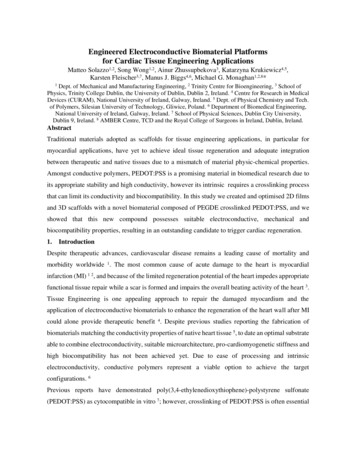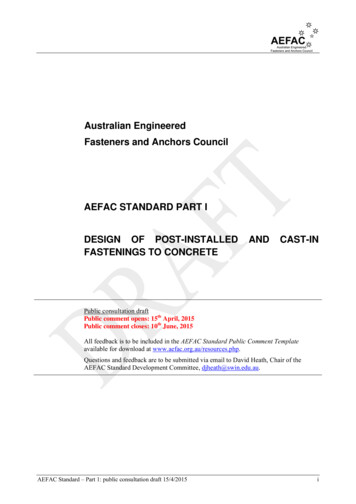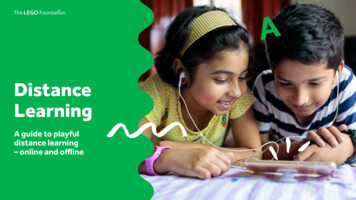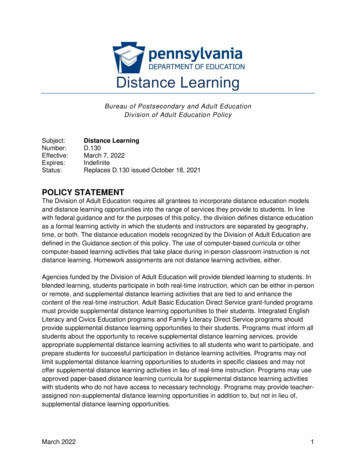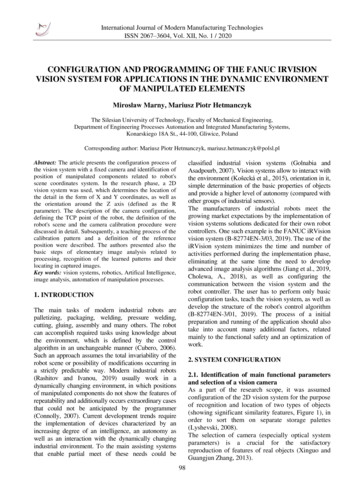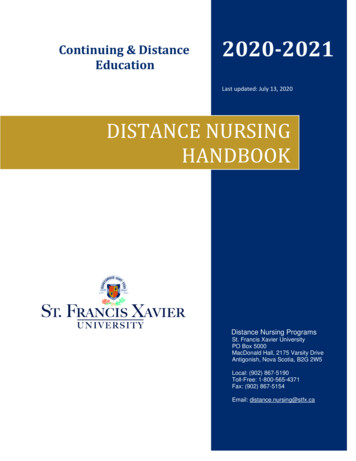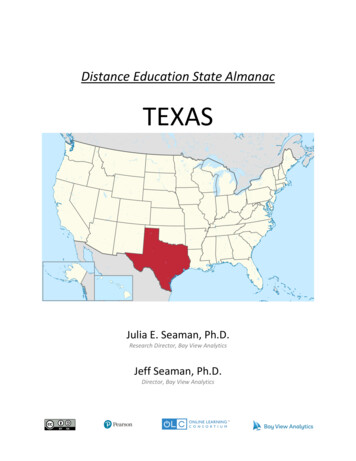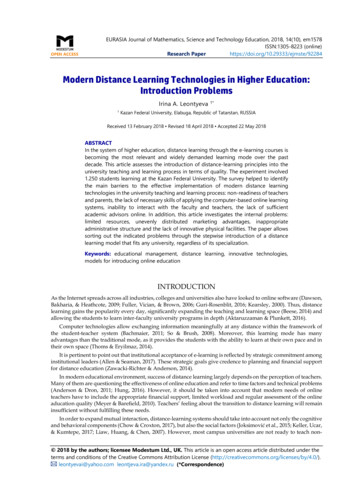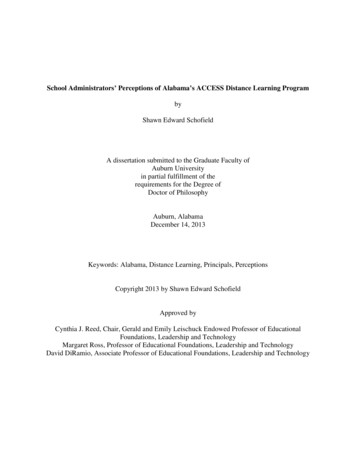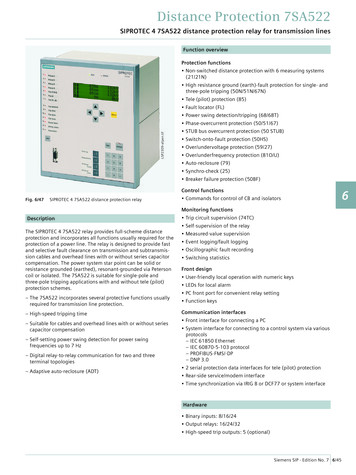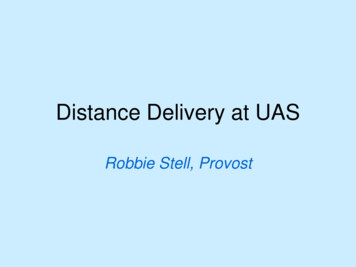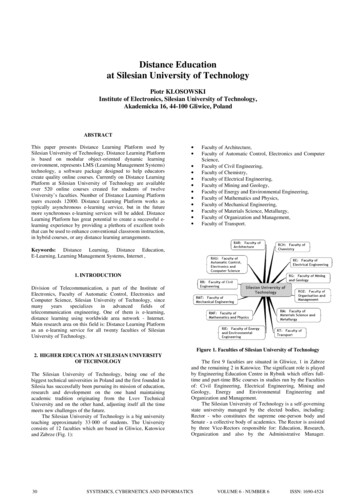
Transcription
Distance Educationat Silesian University of TechnologyPiotr KLOSOWSKIInstitute of Electronics, Silesian University of Technology,Akademicka 16, 44-100 Gliwice, PolandABSTRACTThis paper presents Distance Learning Platform used bySilesian University of Technology. Distance Learning Platformis based on modular object-oriented dynamic learningenvironment, represents LMS (Learning Management Systems)technology, a software package designed to help educatorscreate quality online courses. Currently on Distance LearningPlatform at Silesian University of Technology are availableover 520 online courses created for students of twelveUniversity’s faculties. Number of Distance Learning Platformusers exceeds 12000. Distance Learning Platform works astypically asynchronous e-learning service, but in the futuremore synchronous e-learning services will be added. DistanceLearning Platform has great potential to create a successful elearning experience by providing a plethora of excellent toolsthat can be used to enhance conventional classroom instruction,in hybrid courses, or any distance learning arrangements. Faculty of Architecture,Faculty of Automatic Control, Electronics and ComputerScience,Faculty of Civil Engineering,Faculty of Chemistry,Faculty of Electrical Engineering,Faculty of Mining and Geology,Faculty of Energy and Environmental Engineering,Faculty of Mathematics and Physics,Faculty of Mechanical Engineering,Faculty of Materials Science, Metallurgy,Faculty of Organization and Management,Faculty of Transport.Keywords: Distance Learning, Distance Education,E-Learning, Learning Management Systems, Internet ,1. INTRODUCTIONDivision of Telecommunication, a part of the Institute ofElectronics, Faculty of Automatic Control, Electronics andComputer Science, Silesian University of Technology, munication engineering. One of them is e-learning,distance learning using worldwide area network - Internet.Main research area on this field is: Distance Learning Platformas an e-learning service for all twenty faculties of SilesianUniversity of Technology.Figure 1. Faculties of Silesian University of Technology2. HIGHER EDUCATION AT SILESIAN UNIVERSITYOF TECHNOLOGYThe Silesian University of Technology, being one of thebiggest technical universities in Poland and the first founded inSilesia has successfully been pursuing its mission of education,research and development on the one hand maintainingacademic tradition originating from the Lvov TechnicalUniversity and on the other hand, adjusting itself all the timemeets new challenges of the future.The Silesian University of Technology is a big universityteaching approximately 33 000 of students. The Universityconsists of 12 faculties which are based in Gliwice, Katowiceand Zabrze (Fig. 1):30The first 9 faculties are situated in Gliwice, 1 in Zabrzeand the remaining 2 in Katowice. The significant role is playedby Engineering Education Centre in Rybnik which offers fulltime and part-time BSc courses in studies run by the Facultiesof: Civil Engineering, Electrical Engineering, Mining andGeology, Energy and Environmental Engineering andOrganization and Management.The Silesian University of Technology is a self-governingstate university managed by the elected bodies, including:Rector - who constitutes the supreme one-person body andSenate - a collective body of academics. The Rector is assistedby three Vice-Rectors responsible for: Education, Research,Organization and also by the Administrative Manager.SYSTEMICS, CYBERNETICS AND INFORMATICSVOLUME 6 - NUMBER 6ISSN: 1690-4524
During the 60 years of the Silesian University of Technologythe function of the Rector has been performed by 15professors.The University has the right to confer academic degrees: PhD in Technology - in 17 disciplines, PhD in Physics - in 1 discipline, PhD in Chemistry - in 1 discipline, PhD in Economics - in 1 discipline, DSc in Technical Sciences - 14 disciplines, and DSc in Chemical Sciences.Distance education using Internet, named E-Learning isbased on tree fundamental activities presented on Figure 2 [2]: Creating e-learning content by instructors, Offering e-learning content by servers, Access to e-learning content by students.Restructuring of the 60 years of the University has beenaccompanied by changes in the syllabi. This process is by nomeans completed. The Silesian University of Technology,aiming at receiving the status of technical university, haswidened the educational offer with non-technical studies:Administration and Sociology run at the Faculty ofOrganization and Management.Integration with the European Union and recent changes inthe educational and work market have influenced the increasedinterest in the quality of education. The Silesian University ofTechnology applies actively European standards for highereducation. Flexibility of syllabi, giving each student thepossibility to adjust the subjects to his interest including theinterests overlapping different disciplines, courses andspecializations, is a modern model of education we are aimingat.Main and still valid goal, which the University authoritieshave been striving for during their consecutive terms, is tocombine harmoniously good academic traditions with sustaineddevelopment in every field of activity to keep the SilesianUniversity of Technology distinguished reputation of a modernEuropean technical university.3. INTERNET IN HIGHER EDUCATIONDistance education, or distance learning, is a field of educationthat focuses on the pedagogy, technology, and instructionalsystems design that are effectively incorporated in deliveringeducation to students who are not physically "on site" toreceive their education. Instead, teachers and students maycommunicate asynchronously (at times of their own choosing)by exchanging electronic media, or through technology thatallows them to communicate in real time (synchronously).Distance education courses that require a physical on-sitepresence for any reason including the taking of examinationsis considered to be a hybrid or blended course or program [3].Development research on creating integrated distancelearning system for Silesian University of Technology wasstarted in 2001, but Internet was practical used in educationsince nineties. Technical possibilities using Internet ineducation are in existence since 1991, the year of connectionpolish academic networks to world-wide Internet. SilesianUniversity of Technology was one of several first polishuniversities connected to Internet in 1991.For next years Internet application in education has beenmore and more popular, especially at Faculty of AutomaticControl, Electronics and Computer Science and other faculties,where using personal computers in education is necessary[6,7]. For many years systematizing and regularization allactivities in distance learning at whole University arenecessary. It is the main purpose of Distance Learning Platformat Silesian University of Technology.ISSN: 1690-4524Figure 2. Three Funcamental Activities in E-Learning4. DISTANCE LEARNING PLATFORMDevelopment research on creating integrated DistanceLearning Platform for Silesian University of Technology wasstarted in 2001, at Institute of Electronics, Faculty ofAutomatic Control, Electronics and Computer Science.Research on this area was based on: testing several application useful for distance learning, checking possibilities of adaptation distance learningsoftware to University requirements, attempting to choose one (several) of them to constructdistance learning service for whole University.Tested applications can be differed to three categories: authoring applications : The web authoring tools, courseauthoring tools, media editors, content creatorssoftware to creating and integrating e-learning content(courses, web-pages, multimedia files), LMS (Learning Management System), web servers,database servers, media servers – software to making elearning products (courses) available over a network,hosting, administrating, maintaining, supporting, access applications: e-learning client applications, webbrowsers, media players, communication tools – softwareto locating and experiencing e-learning products.Classification of tested e-learning software is presented onFigure 3.SYSTEMICS, CYBERNETICS AND INFORMATICSVOLUME 6 - NUMBER 631
14 Faculty of Materials Science,http://platforma.polsl.pl/rmMetallurgy15 Faculty of Organization andhttp://platforma.polsl.pl/rozManagement16 Faculty of Faculty of Transport http://platforma.polsl.pl/rtAs results of this research Distance Learning Platform wascreated, as effective, integrated e-learning service for allfaculties of Silesian University of Technology. DistanceLearning Platform has been working at Silesian University ofTechnology since September 2005 (http://platforma.polsl.pl).About 16 virtual servers are integrated to one e-learningservice for twelve faculties of the University. Individual linksto these servers are presented on Table 1.Currently on Distance Learning Platform at SilesianUniversity of Technology are available over 640 online elearning courses Number of users exceeds 17500. Statistics ofeach virtual server is presented on Table 2.Table 2. Statistics of Distance Learning Platformat Silesian University of TechnologyFigure 3. Classification of E-learning SoftwareTable 1. Virtual servers of Distance Learning Platformat Silesian University of TechnologyNr Destination1 Silesian University ofTechnology(main server)2 Faculty of Architecture3 Faculty of Automatic Control,Electronics and ComputerScience4 Faculty of Automatic Control,Electronics and ComputerScience, Institute of Automatic5 Faculty of Automatic Control,Electronics and ComputerScience, Institute of ComputerScience6 Faculty of Automatic Control,Electronics and ComputerScience, Institute ofElectronics7 Faculty of Civil Engineering8 Faculty of Chemistry9 Faculty of ElectricalEngineering10 Faculty of Mining andGeology11 Faculty of Energy andEnvironmental Engineering12 Faculty of Mathematics andPhysics13 Faculty of sl.pl/rauhttp://platforma.polsl.pl/rau1Nr Nr 417566Nr ofcourses102941110117531820201503310264641Distance Learning Platform works as typicallyasynchronous e-learning service, but in the future moresynchronous e-learning services will be added. The mostimportant features of Distance Learning Platform are: Easy creation of courses from existing resources, Course content which can be re-used with differentlearners, including content from other vendors(Blackboard, WebCT etc.), User-friendly environment, Students enrollment and learner authentication are simpleand secure, Intuitive online learner and teacher management orma.polsl.pl/rmt2SYSTEMICS, CYBERNETICS AND INFORMATICSVOLUME 6 - NUMBER 6ISSN: 1690-4524
5. TECHNICAL DETAILS OFDISTANCE LEARNING PLATFORMDistance learning systems are sometimes also called LearningManagement Systems (LMS), Learning Content ManagementSystems (LCMS), Virtual Learning Environments (VLE),education via computer-mediated communication (CMC) orOnline Education [2]. A Learning Management System (LMS)is a software package that enables the management anddelivery of online content to learners. LMS are web-based tofacilitate "anytime, any place, any pace" access to learningcontent and administration. The characteristics of LMSinclude: Manage users, roles, courses, instructors, and facilitiesand generate reports, Course calendar, Learner messaging and notifications, Assessment/testing capable of handling student pre/posttesting, Display scores and transcripts, Grading of coursework and roster processing, Web-based or blended course delivery.System) technology, a software package designed to helpeducators create high quality online courses [8]. DistanceLearning Platform runs without modification on Unix, Linux,FreeBSD, Windows, Mac OS X, NetWare and any othersystems that support PHP, including most webhost providers.Data is stored in a single database: MySQL.Moodle is an alternative to proprietary commercial onlinelearning solutions, and is distributed free under open sourcelicensing [12]. Silesian University of Technologyhascomplete access to the source code and can make changes ifneeded. Moodle’s modular design makes it easy to create newcourses, adding content that will engage learners. Moodle’sintuitive interface makes it easy for instructors to createcourses. Students require only basic browser skills to beginlearning. Front page of Distance Learning Platform andinterface of typical e-learning course are presented on Figure 5and 6.Architecture of Distance Learning Platform as a LearningManagement System is presented on Figure 4.Figure 5. Front Page of Distance Learning Platformavaiable at http://Platforma.polsl.pl.Figure 4. Architecture of Distance Learning PlatformDistance Learning Platform is based on following softwareconfiguration: Unix operating system : FreeBSD 6.1-RELEASE [4], HTTP Server : Apache [1], PHP language interpreter [5], Database server : MySQL [5], Learning Management System: Moodle [12].Distance Learning Platform is based on modular objectoriented dynamic learning environment named Moodle(www.moodle.org), represents LMS (Learning ManagementISSN: 1690-4524Figure 6. Typical Interface of e-learning CourseThe main advantages of Distance Learning Platform are: Promotes a social constructionist pedagogy (collaboration,activities, critical reflection, etc), Suitable for 100% online classes as well as supplementingface-to-face learning ,SYSTEMICS, CYBERNETICS AND INFORMATICSVOLUME 6 - NUMBER 633
Simple, lightweight, efficient, compatible, low-techbrowser interface ,Easy to install on almost any platform that supports PHP.Requires only one database,Full database abstraction supports all major brands ofdatabase ,Course listing shows descriptions for every course on theserver, including accessibility to guests,Courses can be categorized and searched - one DistanceLearning Platform can support thousands of courses ,Emphasis on strong security throughout. Forms are allchecked, data validated, cookies encrypted etc.,Most text entry areas (resources, forum postings, journalentries etc) can be edited using an embedded WYSIWYGHTML editor.Working of Distance Learning Platform is based on four kindsof tools: site management tools, user management tools, coursemanagement and content management tools (Fig. 4). Allfunctions are implemented in separate modules. The mostimportant management features of Distance Learning Platformare presented in next sections. 6. COURSE AND CONTENT MANAGEMENT SYSTEMOF DISTANCE LEARNING PLATFORMCourse management system is designed to facilitate teachers inthe management of educational courses for their students,especially by helping teachers and learners with courseadministration. The system can often track the learners'progress, which can be monitored by both teachers andlearners. While often thought of as primarily tools for distanceeducation, they are most often used to supplement the face-toface classroom.Content management system is used for storing,controlling, versioning, and publishing e-learning content andcourse component such as: electronic files, image media, audiofiles, electronic documents and other web content.The main course and content management systemsfeatures are: Assignment - Used to assign online or offline tasks;learners can submit tasks in any file format (e.g. MSOffice, PDF, image, a/v etc.) Chat - Allows real-time synchronous communication bylearners. Choice - Instructors create a question and a number ofchoices for learners; results are posted for learners toview. Use this module to do quick surveys on subjectmatter. Dialogue - Allows for one-to-one asynchronous messageexchange between instructor and learner, or learner tolearner. Forums - Threaded discussion boards for asynchronousgroup exchange on shared subject matter. Participation inforums can be an integral part of the learning experience,helping students define and evolve their understanding ofsubject matter. Glossary - Create a glossary of terms used in a course.Has display format options including entry list,encyclopedia, FAQ, dictionary style and more. Journal - Learners reflect, record and revise ideas. Label - Add descriptions with images in any area of thecourse homepage.34Lesson - Allows instructor to create and manage a set oflinked "Pages". Each page can end with a question. Thestudent chooses one answer from a set of answers andeither goes forward, backward or stays in the same placein the lesson.Quiz - Create all the familiar forms of assessmentincluding true-false, multiple choice, short answer,matching question, random questions, numericalquestions, embedded answer questions with descriptivetext and graphics. Instructors have granular control indefining course assessments, and can import quizquestions from popular formats like Blackboard, IMS QTIand WebCT. Support embedding audio into a quiz is alsopossible.Resource - The primary tool for bringing content into acourse; may be plain text, uploaded files, links to the web,Wiki or Rich Text (software has built-in text editors) or abibliography type reference. Adding math expressions to aResource activity, using the built-in HTML editor is alsopossible.Survey - This module aids an instructor in making onlineclasses more effective by offering a variety of surveys(COLLES, ATTLS), including critical incident sampling.Workshop An activity for peer assessment ofdocuments (Word, PP etc.) that students submit online.Participants can assess each other’s project. Teachermakes final student assessment, and can control openingand closing periods7. SITE AND USER MANAGEMENT SYSTEM OFDISTANCE LEARNING PLATFORMCreating learning content is only part of what a good LearningManagement System (LMS) must do. The CMS must managelearners in a variety of ways. Learner management includes: Access to information about learners in a course, Ability to segment participants into groups, Site, course and user calendar event scheduling, And so much more: applying scales to different learneractivities, managing grades, tracking user access logs anduploading external files for use within the course etc.One click and learner can view activity from allparticipants enrolled in the course. Learners create a personalprofile that can include a picture, helping connect studentssocially in the online learning community. Learners complete apersonal profile page that helps build the online learningcommunity. Adding a picture and details to the profile createsa social connection. Assigning learners to a group is a commonpractice in education. Software allows the course instructor toeasily create group categories, and determine how memberswill interact with each other and within various activities.Keeping a calendar of events is important to both the learnerand course instructor. Events can be created for differentcategories, including: Global events that appear in all courses (system admin), Course events set by an instructor, Group events set by instructor relative only to a group, User events set by learner (e.g. due dates, personal etc.).Upcoming Events appear on the course homepage, alerting thelearner across all courses they are enrolled in of differentcategory events. Alerts are colour-coded by category.SYSTEMICS, CYBERNETICS AND INFORMATICSVOLUME 6 - NUMBER 6ISSN: 1690-4524
The Administration control panel puts all importantlearner management functions a single click away. Teachersand students can be manually enrolled or removed from acourse. Configuration of course backup and restore is achievedon a single screen. Instructors may define custom scales to beused for grading forums, assignments and journals. Standardscales include assigning a value from 1-100% for eachsubmission (or no grade), and indicating whether the learnerwas demonstrating one of three characteristics in the activity.Monitor shows when and what course resources the learner hasaccessed. Systems Logs provide detailed learner activityCourses include a teacher only forum, where colleaguescan collaborate on tasks and share ideas. Learners find it easyto navigate a course homepage in their browser; intuitive“breadcrumb” links are always present. Login occurs on afamiliar screen. Initial account set up may be handled by thelearner or administrator.Instructors can require an “enrollment key” to allowparticipation in a course. Enrollment keys are provided tolearners separately from the log in process. Courses requiringan enrollment key are indicated in “Course categories”description. Learners can login any time, anywhere to interactwith coursework, and can specify the time zone and languagethey wish to use. When learners “subscribe” to forums they arenotified by e-mail of new postings. Additionally, instructorscan set e-mail notification for private dialogues.8. CONCLUSIONS AND SUMMARYThis paper presents Distance Learning Platform used bySilesian University of Technology. Platform is constantlydeveloped. New interesting features are added as new modulesto source code. New Platform modules implements the mostmodern technology appears in web-based e-learning andInternet services. Example of them is: Web 2.0 technology[10].Web 2.0, refers to a perceived second-generation of webbased communities and hosted services — such as socialnetworking sites — that facilitate collaboration and sharingbetween users [9]. While interested parties continue to debatethe definition of a Web 2.0 application, a Web 2.0 web-sitemay exhibit some basic characteristics [10]. These mightinclude: "Network as platform" — delivering (and allowing usersto use) applications entirely through a browser (weboperating system). Users owning the data on the site and exercising controlover that data. An architecture of participation and democracy thatencourages users to add value to the application as theyuse it. This stands in sharp contrast to hierarchical accesscontrol in applications, in which systems categorize usersinto roles with varying levels of functionality. A rich, interactive, user-friendly interface based on Ajax(Asynchronous JavaScript and XML) or similarframeworks [11] Some social-networking aspects.significant contributes to increase efficiency of students’education at Silesian University of Technology.9. REFERENCES[1] Laurie B., Laurie P., Apache: The Definitive Guide,Third Edition, O'Reilly Media, Inc., ISBN : 0-596-002033, USA 2002.[2] Horton W., Horton K., E-learning Tools andTechnologies : A consumer's guide for trainers,teachers, educators, and instructional designers , WileyPublishing, Inc., ISBN: 0-471-44458-8, USA 2003.[3] Morrison D., E-Learning Strategies – How to getimplementations and delivery right first time , JohnWilley & Sons, ISBN 0-470-84922-3, USA, 2003.[4] Lehey G., The Complete FreeBSD - Documentationfrom the Source, Fourth Edition, O'Reilly Media, Inc.,ISBN : 0-596-00516-4, USA 2003.[5] Williams H., Lane D, Web Database Applications withPHP and MySQL, Second Edition, O'Reilly Media, Inc.,ISBN : 0-596-00543-1, USA 2004.[6] Rutkowski J., Moscinska K., Kłosowski P., ComputerAssisted And Web-Based Learning Techniques InElectronics And telecommunication Education ProcessThe Proceedings of The 7th IASTED InternationalConference on Computers And Advanced Technology inEducation ,CATE 2004, Kauai, Hawaii, USA 2004.[7] RutkowskiJ.,MoscinskaK.,KłosowskiP.Redevelopment of a Large Engineering Course from aTraditional to Blended Model - Circuit TheoryExample,The Proceedings of The 8th IASTEDInternational Conference on Computers And AdvancedTechnology in Education ,CATE 2005, Oranjestad,Aruba, USA 2005.[8] Kłosowski P., Rutkowski J., Moscinska K., DistanceLearning Platform Based on Moodle Open SourceSoftware, The Proceedings of International Conferenceof Engineering Education, ICEE 2005, Gliwice, Poland2005.[9] Henderson C., Building Scalable Web Sites - Building,scaling, and optimizing the next generation of webapplications, O'Reilly Media, Inc., ISBN : 0-596-102356, USA 2006.[10] Ayers D., Bruchez E., Fawcett J., Vernet A., Vlist E.Professional Web 2.0 Programming, Wiley Publishing,Inc., ISBN 978-0-470-08788-6, USA 2006.[11] Mahemoff M., Ajax Design Patterns, O'Reilly Media,Inc., ISBN : 0-596-10180-5, USA 2006.[12] Dougiamas M. ,Moodle Project Documentation, MoodleProject moodle.org, AUSTRALIA, 2007.Majority elements of Web 2.0 technology listed above, arecurrently implemented to Distance Learning Platform.Platform has great potential to create a successful e-learningexperience by providing a plethora of excellent tools that canbe used to enhance conventional classroom instruction, inhybrid courses, or any distance learning arrangements andISSN: 1690-4524SYSTEMICS, CYBERNETICS AND INFORMATICSVOLUME 6 - NUMBER 635
Management Systems (LMS), Learning Content Management Systems (LCMS), Virtual Learning Environments (VLE), education via computer-mediated communication (CMC) or Online Education [2]. A Learning Management System (LMS) is a software package that enables the management and delivery of online content to learners. LMS are web-based to
